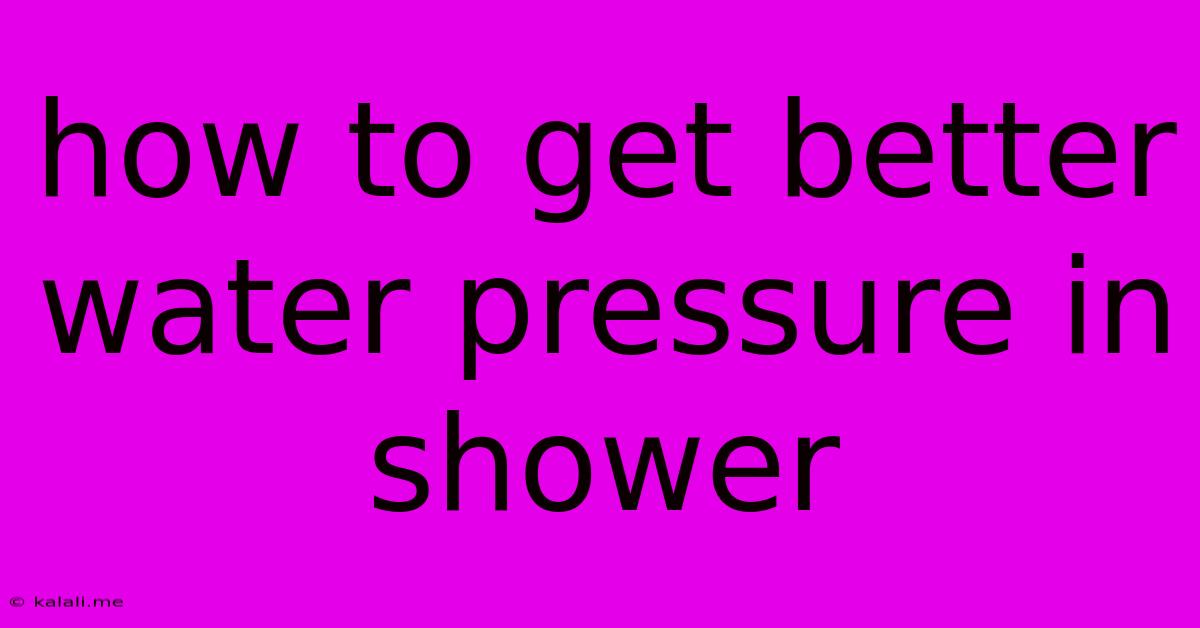How To Get Better Water Pressure In Shower
Kalali
May 21, 2025 · 3 min read

Table of Contents
How to Get Better Water Pressure in Your Shower
Are you tired of a weak, drizzly shower that leaves you feeling less than refreshed? Low water pressure in the shower is a common problem, but thankfully, there are several solutions you can try before calling a plumber. This guide will walk you through troubleshooting and fixing low shower pressure, helping you achieve the invigorating shower experience you deserve.
Understanding Low Water Pressure: Before diving into solutions, it's important to understand the potential causes. Low shower pressure isn't always a problem with your showerhead itself. It could be due to issues with your main water supply, pipes, or even the showerhead's design. Identifying the root cause is crucial for effective problem-solving.
1. Check the Showerhead
The simplest solution is often the most effective. A clogged showerhead restricts water flow, leading to low pressure.
- Inspect the Showerhead: Carefully examine the showerhead for mineral deposits, sediment buildup, or any debris that might be obstructing the spray holes.
- Clean the Showerhead: Soak the showerhead in a solution of white vinegar and water for a few hours, or even overnight. This helps dissolve mineral deposits. For stubborn clogs, use a small pin or needle to clear the spray holes. Remember to rinse thoroughly after cleaning.
- Replace the Showerhead: If cleaning doesn't improve the water pressure, a new showerhead might be the answer. Consider a low-flow showerhead with a high-pressure design; these are engineered to maximize water pressure even with low water flow rates.
2. Examine the Water Pipes
Problems within your plumbing system can significantly impact shower pressure.
- Check for Leaks: Leaks anywhere in your water supply lines reduce overall water pressure. Inspect pipes and fittings for visible leaks. Repair or replace any damaged sections.
- Pipe Diameter: Older homes may have smaller diameter pipes which can restrict water flow. While replacing pipes is a significant undertaking, it's a potential solution for consistently low pressure.
- Check the Water Meter: Observe your water meter before and after turning on the shower. A large difference in the meter reading indicates significant water loss, possibly from a leak.
3. Investigate the Water Heater
Your water heater plays a crucial role in shower pressure.
- Water Heater Sediment Buildup: Over time, sediment can accumulate at the bottom of your water heater, restricting water flow. Flushing your water heater once a year can resolve this issue. Check your water heater manual for instructions.
- Water Heater Size: If you have a small water heater for a large house, it may struggle to provide sufficient hot water for all fixtures simultaneously. Consider upgrading to a larger capacity tankless water heater if you have recurring issues.
4. Consider Aerators and Flow Restrictors
Certain fixtures may contain flow restrictors or aerators which reduce water usage but may also reduce pressure.
- Remove Flow Restrictors: Some showerheads and faucets include built-in flow restrictors to conserve water. Removing these can increase water pressure, but may also increase your water bill.
- Remove Aerators: Aerators mix air with water to save water, but can also decrease pressure. Removing them may provide a noticeable improvement.
5. When to Call a Plumber
If you've tried the above solutions and still experience low water pressure, it's time to call a professional plumber. They can diagnose more complex problems like:
- Clogged pipes: A severe blockage in your main water line or shower line requires professional expertise to clear.
- Low water pressure throughout the house: This suggests a problem with your main water supply, requiring a professional assessment.
- Water pressure regulator issues: A malfunctioning pressure regulator can significantly impact water pressure in your home.
By systematically checking these areas, you can effectively troubleshoot and improve your shower's water pressure. Remember to prioritize safety and consider professional assistance for complex plumbing issues. A strong, satisfying shower is within reach!
Latest Posts
Latest Posts
-
Mounting A Tv On A Chimney Breast
May 21, 2025
-
What Can I Use Instead Of Curry Powder
May 21, 2025
-
Plug Sockets In Republic Of Ireland
May 21, 2025
-
String Or Binary Data Would Be Truncated
May 21, 2025
-
Is It Haram To Eat With Left Hand
May 21, 2025
Related Post
Thank you for visiting our website which covers about How To Get Better Water Pressure In Shower . We hope the information provided has been useful to you. Feel free to contact us if you have any questions or need further assistance. See you next time and don't miss to bookmark.